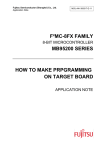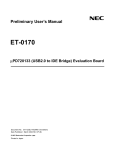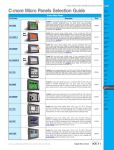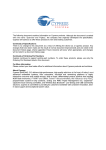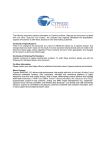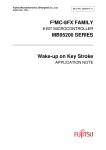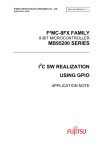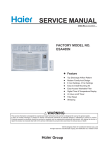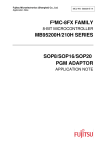Download Application Note
Transcript
The following document contains information on Cypress products. Colophon The products described in this document are designed, developed and manufactured as contemplated for general use, including without limitation, ordinary industrial use, general office use, personal use, and household use, but are not designed, developed and manufactured as contemplated (1) for any use that includes fatal risks or dangers that, unless extremely high safety is secured, could have a serious effect to the public, and could lead directly to death, personal injury, severe physical damage or other loss (i.e., nuclear reaction control in nuclear facility, aircraft flight control, air traffic control, mass transport control, medical life support system, missile launch control in weapon system), or (2) for any use where chance of failure is intolerable (i.e., submersible repeater and artificial satellite). Please note that Spansion will not be liable to you and/or any third party for any claims or damages arising in connection with above-mentioned uses of the products. Any semiconductor devices have an inherent chance of failure. You must protect against injury, damage or loss from such failures by incorporating safety design measures into your facility and equipment such as redundancy, fire protection, and prevention of over-current levels and other abnormal operating conditions. If any products described in this document represent goods or technologies subject to certain restrictions on export under the Foreign Exchange and Foreign Trade Law of Japan, the US Export Administration Regulations or the applicable laws of any other country, the prior authorization by the respective government entity will be required for export of those products. Trademarks and Notice The contents of this document are subject to change without notice. This document may contain information on a Spansion product under development by Spansion. Spansion reserves the right to change or discontinue work on any product without notice. The information in this document is provided as is without warranty or guarantee of any kind as to its accuracy, completeness, operability, fitness for particular purpose, merchantability, non-infringement of third-party rights, or any other warranty, express, implied, or statutory. Spansion assumes no liability for any damages of any kind arising out of the use of the information in this document. ® ® ® TM Copyright © 2013 Spansion Inc. All rights reserved. Spansion , the Spansion logo, MirrorBit , MirrorBit Eclipse , TM ORNAND and combinations thereof, are trademarks and registered trademarks of Spansion LLC in the United States and other countries. Other names used are for informational purposes only and may be trademarks of their respective owners. Fujitsu Semiconductor (Shanghai) Co., Ltd. Application Note MCU-AN- 500017-E-11 F²MC-8FX FAMILY 8-BIT MICROCONTROLLER MB95200 SERIES HOW TO MAKE PRPGRAMMING ON TARGET BOARD APPLICATION NOTE How to Make Programming Interface on Target Board V1.1 Revision History Revision History Date 2009-2-10 2009-2-11 2010-1-11 Author Benjamin. Yang Benjamin. Yang Ivan. Xiao Change of Records V1.0, First draft V1.1, Modify V1.1, Add a note to page 14 This manual contains 17 pages. 1. The products described in this manual and the specifications thereof may be changed without prior notice. To obtain up-to-date information and/or specifications, contact your Fujitsu sales representative or Fujitsu authorized dealer. 2. Fujitsu will not be liable for infringement of copyright, industrial property right, or other rights of a third party caused by the use of information or drawings described in this manual. 3. The contents of this manual may not be transferred or copied without the express permission of Fujitsu. 4. The products contained in this manual are not intended for use with equipments which require extremely high reliability such as aerospace equipments, undersea repeaters, nuclear control systems or medical equipments for life support. 5. Some of the products described in this manual may be strategic materials (or special technology) as defined by the Foreign Exchange and Foreign Trade Control Law. In such cases, the products or portions thereof must not be exported without permission as defined under the law. © 2008 Fujitsu Semiconductor (Shanghai) Co., Ltd. MCU-AN- 500017-E-11 – Page 2 How to Make Debug Interface on Target Board V1.1 CONTENTS CONTENTS REVISION HISTORY .............................................................................................................. 2 1 INTRODUCTION ................................................................................................................ 4 2 APPLICATION ENVIRONMENT ........................................................................................ 5 2.1 Programming Tool..................................................................................................... 5 2.2 SOFTUNE ................................................................................................................. 5 2.3 USB Programmer ...................................................................................................... 6 3 MCU PRODUCTS .............................................................................................................. 7 4 HARDWARE DESIGN ....................................................................................................... 8 4.1 Single Flash MCU Programming Circuit ................................................................... 8 4.2 Dual Flash MCU Programming Circuit ...................................................................... 9 5 PROGRAMMING PROCESS ........................................................................................... 10 5.1 Use MB95200 Series USB Programmer to Program .............................................. 10 5.1.1 Hardware Connection ............................................................................... 10 5.1.2 Programming Step .................................................................................... 10 5.2 Use F2MC-8L/8FX SOFTUNE to Program ............................................................. 12 6 TROUBLE SHOOTING .................................................................................................... 15 6.1 Solve the Error Message Window from USB Programmer ..................................... 15 6.2 Solve the Error Message Window from SOFTUNE ................................................ 15 7 ADDITIONAL INFORMATION ......................................................................................... 16 8 APPENDIX ....................................................................................................................... 17 8.1 Tables ..................................................................................................................... 17 8.2 Figures .................................................................................................................... 17 MCU-AN- 500017-E-11– Page 3 How to Make Programming Interface on Target Board V1.1 Chapter 1 Introduction 1 Introduction Programming to target board is a very important step for project design. This document shows you how to make programming to target board. In this part, you can realize the programming function process. The programming interface in this document could be used as an in-circuit debug and incircuit programming tool. MCU-AN- 500017-E-11 – Page 4 How to Make Debug Interface on Target Board V1.1 Chapter 2 Application Environment 2 Application Environment This chapter introduces the application environment of MB95200H/210H SOP20 PGM adaptor. 2.1 Programming Tool The debug tool is BGMA (BGM Adaptor), the type of it is MB2146-08-E, as below picture. It can be gotten from MB95200 MCU Starter Kit (PN: MB2146-410-01-E). Figure 2-1 BGM Adaptor 2.2 SOFTUNE SOFTUNE is used to program and debug, as software development environment. The version of it is F2MC-8L/8FX SOFTUNE Workbench V30L31, as below picture. It can be gotten from MB95200 MCU Starter Kit (PN: MB2146-410-01-E), or downloaded from website: http://www.fujitsu.com/cn/fss/services/mcu/tools.html Figure 2-2 SOFTUNE Version MCU-AN- 500017-E-11– Page 5 How to Make Programming Interface on Target Board V1.1 Chapter 2 Application Environment 2.3 USB Programmer The MB95200 series USB programmer is as below picture. It can be downloaded from Web: http://www.fujitsu.com/cn/fss/services/mcu/tools.html Figure 2-3 MB95200 Series USB Programmer MCU-AN- 500017-E-11 – Page 6 How to Make Debug Interface on Target Board V1.1 Chapter 3 MCU Products 3 MCU Products This chapter introduces MCU product which is suit to this document. This in-circuit programming circuit have some differences between single flash MCU and dual flash MCU. This part will list you the two types of MCU as follow. Table 3-1 MCU Products Series Flash Type Chip list Series Flash Type MB95F202K MB95F200H MB95F210H Single Flash Single Flash MB95F262K MB95F202H MB95F203K MB95F260H MB95F220H Dual Flash MB95F262H MB95F263K MB95F203H MB95F263H MB95F204K MB95F264K MB95F204H MB95F264H MB95F212K MB95F272K MB95F212H MB95F213K MB95F270H Dual Flash MB95F272H MB95F273K MB95F213H MB95F273H MB95F214K MB95F274K MB95F214H MB95F274H MB95F222K MB95F282K MB95F222H Single Flash Chip list MB95F223K MB95F280H Dual Flash MB95F223H MB95F282H MB95F283K MB95F283H MB95F284K MB95F284H MB95F332K MB95F332H MB95F330H Dual Flash MB95F333K MB95F333H MB95F334K MB95F334H MCU-AN- 500017-E-11– Page 7 How to Make Programming Interface on Target Board V1.1 Chapter 4 Hardware Design 4 Hardware Design This chapter introduces programming steps using either MB95200 series USB programmer or F2MC-8L/8FX SOFTUNE Workbench V30L31. As Chapter 3 shows that the MCUs have two types, the debug circuit have any differences. This chapter will give you the different types MCU programming circuit. 4.1 Single Flash MCU Programming Circuit The follows figure shows the circuit diagram of the in-system programming interface. To design this in-system programmer interface, we need four pins, UVCC_EV, GND, RSTIN, and DBG. (RST_OUT if necessary, please add it). Target Board Figure 4-1 Basic Circuit for Single Flash MCU Components Recommendation: D1: VF < 0.3V when IF = 1mA. E.g. LL103A, 1SS294 Following list shows the functions of the interface connector. (1) J1 is a 10 pins connector which is the interface of this circuit. (2) The write voltage (VCC = 4.5V to 5.5V) is supplied from the user system. UVCC_EV and DBG pin timing controls the PGM mode entry. (3) Pin2 of the connector used to connect the GND. (4) Programmer provides 10V directly to RSTX pin during flash erase/write operation. If it is pulled high in user system, please consider to add a low-drop diode for separate H voltage. (5) DBG pin provides 1-line UART communication with the Programmer. Serial write mode can be set if provide special timing of DBG and VCC pin. MCU-AN- 500017-E-11 – Page 8 How to Make Debug Interface on Target Board V1.1 Chapter 4 Hardware Design 4.2 Dual Flash MCU Programming Circuit The follows figure shows the circuit diagram of the in-system debug interface. To design this in-system programmer interface, we need three pins, UVCC_EV, GND and DBG. (RST_OUT if necessary please add) Target Board Figure 4-2 Basic Circuit for Single Flash MCU Components Recommendation: D1: VF < 0.3V when IF = 1mA. E.g. LL103A, 1SS294 Following list shows the functions of the interface connector. (1) J1 is a 10 pins connector which is the interface of this circuit. (2) The write voltage (VCC = 4.5V to 5.5V) is supplied from the user system. UVCC_EV and DBG pin timing controls the PGM mode entry. (3) Pin2 of the connector used to connect the GND. (4) DBG pin provides 1-line UART communication with the Programmer. Serial write mode can be set if provide special timing of DBG and VCC pin. MCU-AN- 500017-E-11– Page 9 How to Make Programming Interface on Target Board V1.1 Chapter 5 Programming Process 5 Programming Process 5.1 Use MB95200 Series USB Programmer to Program 5.1.1 Hardware Connection (1) Connect BGM adapter with computer by USB, then connect it with target board. Adapter interface PC USB connector (2) Power up MCU on the target board. Please note: user must give the power supply to the target board after connecting target board with BGM adaptor. 5.1.2 Programming Step (1) Open MB95200 series USB programmer (2) Select MCU type (3) Select mhx file at the path: Current project DIR\Debug\ABS (2) (3) Figure 5-1 Select MCU Type and Hex File (4) Click Full Operation to do programming. MCU-AN- 500017-E-11 – Page 10 How to Make Debug Interface on Target Board V1.1 Chapter 5 Programming Process Figure 5-2 Click Full Operation (5) The USB programmer also provides single operation, including Erase, Blank Check, Program, Read & Compare and Copy. MCU-AN- 500017-E-11– Page 11 How to Make Programming Interface on Target Board V1.1 Chapter 5 Programming Process 5.2 Use F2MC-8L/8FX SOFTUNE to Program (1) Connect BGMA to PC (2) Connect EV-board to BGMA (3) Power on the EV-board (1) (2) (3) Figure 5-3 Indicate Process 1-3 (4) Open a project (E.g. IO_LED) using SOFTUNE Figure 5-4 Open Demo Project MCU-AN- 500017-E-11 – Page 12 How to Make Debug Interface on Target Board V1.1 Chapter 5 Programming Process (5) Start debug. Figure 5-5 Start Debug (6) Run a step, and the system begin to program. (Press F5 or F6 on the keyboard or click step in or step over in the workbench) Step in and step over Figure 5-6 Begin to Program MCU-AN- 500017-E-11– Page 13 How to Make Programming Interface on Target Board V1.1 Chapter 5 Programming Process Note: SOFTUNE will change watchdog bit in MCU with watchdog setting(as follows), but USB programmer (include dedicated software) will not, so when use SOFTUNE to debugging and programming, please pay more attention on watchdog setting, below are 2 conditions to use watchdog: 1. Use SOFTUNE debugging and programming: -Set SOFTUNE watchdog setting the same as code setting, enable or disable 2. Use USB programmer (include dedicated software) to programming: -Just enable watchdog or disable watchdog in code. For how to use watchdog, please refer to “MCU-AN-500013-E-11 (Watchdog Timer Application Note)” Figure 5-7 Watchdog Setting Menu Figure 5-8 Watchdog Setting Option MCU-AN- 500017-E-11 – Page 14 How to Make Debug Interface on Target Board V1.1 Chapter 6 Trouble Shooting 6 Trouble Shooting 6.1 Solve the Error Message Window from USB Programmer (1) When using the USB programmer, please choose the right target microcontroller type. Or error occurs as below. Figure 6-1 Error about MCU Selection (2) When user connects the power supply before BGM adapter connector, the error as below will occur. Figure 6-2 Error about Connecting Order by Using USB Programmer 6.2 Solve the Error Message Window from SOFTUNE (1) When user connects the power supply before BGM adapter connector, the error as below will occur. Figure 6-3 Error about Connecting by Using SOFTUNE MCU-AN- 500017-E-11– Page 15 How to Make Programming Interface on Target Board V1.1 Chapter 7 Additional Information 7 Additional Information For more information about how to use MB9595200H/210H EV-board, BGM Adaptor and SOFTUNE, please refer to SKT MB2146-410-01-E User Manual, or visit following websites: English version: http://www.fujitsu.com/cn/fsp/services/mcu/mb95/application_notes.html Simplified Chinese Version: http://www.fujitsu.com/cn/fss/services/mcu/mb95/application_notes.html MCU-AN- 500017-E-11 – Page 16 How to Make Debug Interface on Target Board V1.1 Chapter 8 Appendix 8 Appendix 8.1 Tables Table 3-1 MCU Products ......................................................................................................... 7 8.2 Figures Figure 2-1 BGM Adaptor .......................................................................................................... 5 Figure 2-2 SOFTUNE Version ................................................................................................. 5 Figure 2-3 MB95200 Series USB Programmer ........................................................................ 6 Figure 4-1 Basic Circuit for Single Flash MCU ........................................................................ 8 Figure 4-2 Basic Circuit for Single Flash MCU ........................................................................ 9 Figure 5-1 Select MCU Type and Hex File ............................................................................ 10 Figure 5-2 Click Full Operation .............................................................................................. 11 Figure 5-3 Indicate Process 1-3 ............................................................................................. 12 Figure 5-4 Open Demo Project .............................................................................................. 12 Figure 5-5 Start Debug .......................................................................................................... 13 Figure 5-6 Begin to Program .................................................................................................. 13 Figure 5-7 Watchdog Setting Menu ....................................................................................... 14 Figure 5-8 Watchdog Setting Option ...................................................................................... 14 Figure 6-1 Error about MCU Selection ................................................................................... 15 Figure 6-2 Error about Connecting Order by Using USB Programmer .................................. 15 Figure 6-3 Error about Connecting by Using SOFTUNE ....................................................... 15 MCU-AN- 500017-E-11– Page 17



















